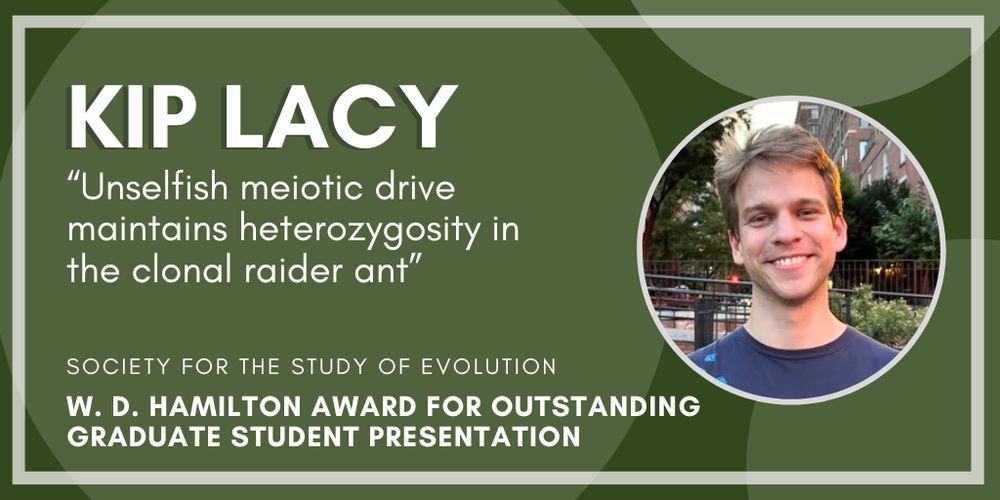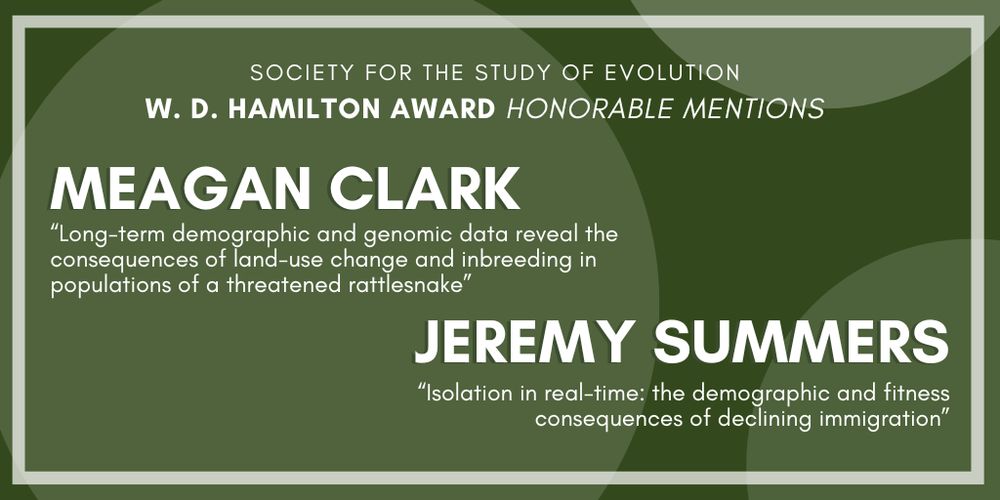
Tomas Kay
@tomaskay.bsky.social
Ant biologist & naturalist. Post-doc at the Rockefeller University and junior fellow of the Simon's Society of Fellows
Reposted by Tomas Kay
New article from the lab out today, in which we discuss how social behavior evolves at the molecular level. From parenting across the animal tree of life to caste systems in social insects, it’s all connected (and, therefore, slowly starts to make sense)…
Parental care, and more complex cooperative systems of care, have independently evolved in hundreds of animal lineages. In an article published today, we explore how these behaviors evolve 𝘢𝘵 𝘢 𝘮𝘰𝘭𝘦𝘤𝘶𝘭𝘢𝘳 𝘭𝘦𝘷𝘦𝘭l shorturl.at/g5OPw /1

Convergent evolution of a conserved molecular network underlies parenting and sociality - Nature Reviews Genetics
Kay et al. review evidence that parental care, and more complex social behaviour based on parental care, evolved in multiple species through the repeated co-option of members of a pleiotropic molecula...
shorturl.at
November 4, 2025 at 4:41 PM
New article from the lab out today, in which we discuss how social behavior evolves at the molecular level. From parenting across the animal tree of life to caste systems in social insects, it’s all connected (and, therefore, slowly starts to make sense)…
Parental care, and more complex cooperative systems of care, have independently evolved in hundreds of animal lineages. In an article published today, we explore how these behaviors evolve 𝘢𝘵 𝘢 𝘮𝘰𝘭𝘦𝘤𝘶𝘭𝘢𝘳 𝘭𝘦𝘷𝘦𝘭l shorturl.at/g5OPw /1

Convergent evolution of a conserved molecular network underlies parenting and sociality - Nature Reviews Genetics
Kay et al. review evidence that parental care, and more complex social behaviour based on parental care, evolved in multiple species through the repeated co-option of members of a pleiotropic molecula...
shorturl.at
November 4, 2025 at 3:57 PM
Parental care, and more complex cooperative systems of care, have independently evolved in hundreds of animal lineages. In an article published today, we explore how these behaviors evolve 𝘢𝘵 𝘢 𝘮𝘰𝘭𝘦𝘤𝘶𝘭𝘢𝘳 𝘭𝘦𝘷𝘦𝘭l shorturl.at/g5OPw /1
Reposted by Tomas Kay
What does mating look like when you only have a single shot at getting it right?
Very excited to share our work on an almost-invisible female control, rapidly evolving mating recognition systems, and species that break the rules and take over the world. IN MOSQUITOES>
Very excited to share our work on an almost-invisible female control, rapidly evolving mating recognition systems, and species that break the rules and take over the world. IN MOSQUITOES>

October 28, 2025 at 8:57 PM
What does mating look like when you only have a single shot at getting it right?
Very excited to share our work on an almost-invisible female control, rapidly evolving mating recognition systems, and species that break the rules and take over the world. IN MOSQUITOES>
Very excited to share our work on an almost-invisible female control, rapidly evolving mating recognition systems, and species that break the rules and take over the world. IN MOSQUITOES>
Reposted by Tomas Kay
@AntCommunity 🐜 🐜 Chengyuan Liu found a Camponotus ant colony where all sexual larvae have red spots of various sizes, but worker larvae don’t. Any idea what this is?🤔 Video in the comment.


September 29, 2025 at 9:58 AM
@AntCommunity 🐜 🐜 Chengyuan Liu found a Camponotus ant colony where all sexual larvae have red spots of various sizes, but worker larvae don’t. Any idea what this is?🤔 Video in the comment.
Playing hide-and-seek with saltmarsh sparrows at Plumb beach: This East coast endemic inhabits coastal salt marshes and is endangered by habitat loss

September 26, 2025 at 7:54 PM
Playing hide-and-seek with saltmarsh sparrows at Plumb beach: This East coast endemic inhabits coastal salt marshes and is endangered by habitat loss
These two mourning geckos looked like they were mating outside my hotel room in Gamboa, Panama. They are both female. The mourning gecko is an all female species that engages in pseudo-copulation to stimulate egg laying. Not sure I’ve knowingly seen female-female mounting before.

July 13, 2025 at 4:35 PM
These two mourning geckos looked like they were mating outside my hotel room in Gamboa, Panama. They are both female. The mourning gecko is an all female species that engages in pseudo-copulation to stimulate egg laying. Not sure I’ve knowingly seen female-female mounting before.
A 𝘾𝙚𝙥𝙝𝙖𝙡𝙤𝙩𝙚𝙨 𝙖𝙩𝙧𝙖𝙩𝙪𝙨 worker with a strepsipteran parasite in its abdomen. Male strepsipterans look like normal insects but females are neotenic, retaining larval form throughout their lives. Females implant themselves into the abdomens of other insects & expose their anterior tip /1



July 12, 2025 at 4:49 PM
A 𝘾𝙚𝙥𝙝𝙖𝙡𝙤𝙩𝙚𝙨 𝙖𝙩𝙧𝙖𝙩𝙪𝙨 worker with a strepsipteran parasite in its abdomen. Male strepsipterans look like normal insects but females are neotenic, retaining larval form throughout their lives. Females implant themselves into the abdomens of other insects & expose their anterior tip /1
(1) A moulting Cicada. (2) Moulding is a vulnerable moment - a moulting cicada getting eaten alive by big-headed ants. And (3) aduldhood also dangerous! A cicada in the mouth of a broad-billed motmot. Over the past few days in Panama.



July 11, 2025 at 12:17 AM
(1) A moulting Cicada. (2) Moulding is a vulnerable moment - a moulting cicada getting eaten alive by big-headed ants. And (3) aduldhood also dangerous! A cicada in the mouth of a broad-billed motmot. Over the past few days in Panama.
Reposted by Tomas Kay
I am humbled and honored to have received this year’s Hamilton Award! Thanks to the @sse-evolution.bsky.social , to my advisor @danielkronauer.bsky.social and the @rockefelleruniv.bsky.social graduate program, and to everyone else who helped me along the way and made this possible.
Congratulations to this year’s Hamilton Award winner, Kip Lacy, and Honorable Mentions Meagan Clark and Jeremy Summers! www.evolutionsociety.org/news/display...
Watch their outstanding talks from virtual #Evol2025: www.youtube.com/watch?v=Mzh3...
Watch their outstanding talks from virtual #Evol2025: www.youtube.com/watch?v=Mzh3...


June 20, 2025 at 5:05 PM
I am humbled and honored to have received this year’s Hamilton Award! Thanks to the @sse-evolution.bsky.social , to my advisor @danielkronauer.bsky.social and the @rockefelleruniv.bsky.social graduate program, and to everyone else who helped me along the way and made this possible.
Central Park is full of active Robin's nests at the moment. This one is at eye-level on the North side of the Pool @birdcpk.bsky.social

June 3, 2025 at 3:46 PM
Central Park is full of active Robin's nests at the moment. This one is at eye-level on the North side of the Pool @birdcpk.bsky.social
An American oystercatcher feeding its chick today at Rockaway beach, NY.

May 25, 2025 at 10:22 PM
An American oystercatcher feeding its chick today at Rockaway beach, NY.
No kiss required to turn this pickerel frog into a prince. Catskills, NY.

May 19, 2025 at 1:43 PM
No kiss required to turn this pickerel frog into a prince. Catskills, NY.
What a snake!
A highlight from today’s walk at Onteora Lake in the Catskills with @pbrand.bsky.social and @tomaskay.bsky.social was this Eastern Copperhead (Agkistrodon contortrix), one of the few venomous snakes in New York. They are very well camouflaged and tend not to move, so are hard to spot.



May 19, 2025 at 1:39 PM
What a snake!
One of two wrentits rehydrating at a dripping pipe in Mission Trails, California. These are endemic to west coast scrubland, from Oregon south to Baja California, and are the only New World representative of the Parrotbills. They form lifelong pair bonds.

January 29, 2025 at 2:16 AM
One of two wrentits rehydrating at a dripping pipe in Mission Trails, California. These are endemic to west coast scrubland, from Oregon south to Baja California, and are the only New World representative of the Parrotbills. They form lifelong pair bonds.
Pink-footed geese wintering in Norfolk, where they form flocks of thousands and feed on post-harvest sugar beet tops.

December 12, 2024 at 9:49 AM
Pink-footed geese wintering in Norfolk, where they form flocks of thousands and feed on post-harvest sugar beet tops.

